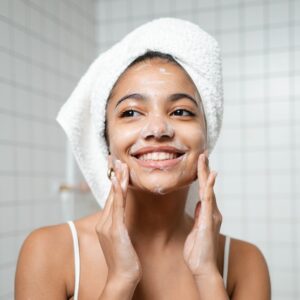Having a skincare routine is essential for maintaining healthy, radiant skin. With so many products and steps to choose from, it can be overwhelming to figure out the best skincare routine that suits your skin type and concerns. In this blog post, we will delve into the world of skincare routines, exploring the best practices and order of skincare products, tailored for different skin types, including oily skin, sensitive skin, and combination skin. Whether you’re a skincare newbie or a seasoned enthusiast, this guide will help you create a skincare routine that works for you, so you can achieve your best skin ever!
Understanding the Basics of Skincare Routines
Skincare routines are not just a fad, but a crucial aspect of maintaining healthy skin. They consist of a series of steps that are designed to cleanse, nourish, protect, and treat the skin. The basic steps of a skincare routine typically include cleansing, toning, treating, moisturizing, and applying sunscreen during the day. These steps help to remove dirt, oil, and impurities, balance the skin’s pH, deliver active ingredients, provide hydration, and protect the skin from environmental damage.
It’s important to note that skincare routines can vary depending on individual skin types and concerns, but the general principles remain the same. Consistency is key, and following a skincare routine diligently can yield visible results over time.
Building the Best Skincare Routine for Your Skin Type
Understanding your skin type is crucial in building an effective skincare routine. Different skin types have unique needs and concerns, and tailoring your routine accordingly can help address those concerns effectively.
a) Skincare Routine for Oily Skin
If you have oily skin, your skincare routine should focus on controlling excess oil production, unclogging pores, and preventing breakouts. Look for oil-free or non-comedogenic products that won’t clog your pores, and opt for lightweight, mattifying moisturizers. Incorporating products with salicylic acid or tea tree oil can help control excess oil and combat acne. Double cleansing, using an oil-based cleanser followed by a water-based cleanser, can effectively remove excess oil and impurities without stripping the skin’s natural moisture.
b) Skincare Routine for Sensitive Skin
Sensitive skin requires gentle care to avoid irritation and redness. Look for fragrance-free, hypoallergenic, and gentle products formulated for sensitive skin. Avoid harsh scrubs, alcohol-based toners, and fragrant products that can potentially trigger sensitivity. Opt for soothing ingredients such as aloe vera, chamomile, or calendula to calm and nourish the skin. Patch testing new products is essential to ensure they won’t cause adverse reactions.
c) Skincare Routine for Combination Skin
Combination skin is characterized by having both oily and dry areas on the face. It requires a balanced approach to address both concerns effectively. Focus on gentle cleansing to avoid stripping the skin’s natural oils, and use lightweight moisturizers that provide hydration without adding excess oil. Look for products that can balance the skin, such as niacinamide or hyaluronic acid, which can hydrate dry areas and regulate oil production in oily areas.
Mastering the Order of Skincare Products
The order in which skincare products are applied is crucial for their efficacy. Follow these steps for a typical skincare routine:
Step 1: Oil-based cleanser
- What is it: An oil-based cleanser is a cleanser that uses oils to dissolve and remove oil-based impurities from the skin, such as makeup, sunscreen, and excess sebum.
- How to use it: Apply a small amount of the oil-based cleanser to dry skin and massage it in circular motions. Rinse with lukewarm water and pat dry.
- Who is it for: Oil-based cleansers are suitable for all skin types, but especially beneficial for those with dry or sensitive skin.
- Type for skin type: Look for oil-based cleansers with nourishing oils, such as jojoba oil, coconut oil, or argan oil, for dry or sensitive skin. For oily or acne-prone skin, choose oil-based cleansers with lighter oils, such as grapeseed oil or tea tree oil.
Step 2: Water-based cleanser
- What is it: A water-based cleanser is a cleanser that uses water to cleanse the skin from water-based impurities, such as sweat, dirt, and pollutants.
- How to use it: After using the oil-based cleanser, apply a small amount of the water-based cleanser to damp skin and massage in gentle circular motions or use a facial cleansing device to apply it onto your skin. Rinse thoroughly with lukewarm water and pat dry.
- Who is it for: Water-based cleansers are suitable for all skin types.
- Type for skin type: Look for water-based cleansers with hydrating and soothing ingredients, such as hyaluronic acid, aloe vera, or cucumber extract, for dry or sensitive skin. For oily or acne-prone skin, choose water-based cleansers with salicylic acid, tea tree oil, or witch hazel extract.
Step 3: Toner or astringent
- What is it: A toner or astringent is a liquid product that helps to balance the skin’s pH, remove any remaining traces of impurities, and tighten the pores.
- How to use it: After cleansing, apply the toner or astringent to a cotton pad and gently swipe it over your face and neck, avoiding the eye area.
- Who is it for: Toners or astringents are suitable for all skin types, but especially beneficial for those with oily or acne-prone skin.
- Type for skin type: Look for toners or astringents with ingredients like witch hazel, rose water, or tea tree oil for oily or acne-prone skin. For dry or sensitive skin, choose toners or astringents with hydrating and soothing ingredients, such as chamomile extract or calendula extract.
Step 4: Antioxidant serum
- What is it: An antioxidant serum is a lightweight liquid product that contains antioxidants, such as vitamins C and E, to protect the skin from environmental damage and help brighten the complexion.
- How to use it: Apply a few drops of the antioxidant serum to your fingertips and gently pat it onto your face and neck, avoiding the eye area.
- Who is it for: Antioxidant serums are suitable for all skin types, especially beneficial for those concerned with dullness, uneven skin tone, or environmental damage.
- Type for skin type: Look for antioxidant serums with stable forms of vitamin C, such as L-ascorbic acid, for normal or dry skin. For oily or acne-prone skin, choose antioxidant serums with lightweight textures, such as serums with niacinamide or green tea extract.
Step 5: Spot treatment
- What is it: A spot treatment is a targeted treatment for specific areas of the skin that are prone to breakouts or have existing blemishes, such as acne spots or dark spots.
- How to use it: Apply a small amount of the spot treatment directly onto the affected area and gently pat it in with clean fingertips.
- Who is it for: Spot treatments are suitable for those with acne-prone skin or those who have specific areas of concern, such as dark spots or blemishes.
- Type for skin type: Look for spot treatments with acne-fighting ingredients, such as benzoyl peroxide, salicylic acid, or tea tree oil, for oily or acne-prone skin. For dark spots or hyperpigmentation, choose spot treatments with brightening ingredients, such as vitamin C, kojic acid, or hydroquinone.
Step 6: Eye cream
- What is it: An eye cream is a specialized moisturizer formulated for the delicate skin around the eyes, which is prone to dryness, fine lines, and wrinkles.
- How to use it: Gently pat a small amount of the eye cream onto the skin around the eyes using your ring finger, as it applies the least amount of pressure.
- Who is it for: Eye creams are suitable for all skin types, but especially beneficial for those with dry or mature skin, or those concerned with signs of aging around the eyes.
- Type for skin type: Look for eye creams with hydrating and nourishing ingredients, such as hyaluronic acid, peptides, or ceramides, for dry or mature skin. For sensitive skin, choose eye creams with gentle and soothing ingredients, such as chamomile extract or aloe vera.
Step 7: Lighter face oil
- What is it: A lighter face oil is a lightweight oil-based product that can be used to provide additional hydration, nourishment, and glow to the skin.
- How to use it: Warm a few drops of the lighter face oil between your palms and gently press it onto your face and neck, avoiding the eye area, using upward and outward motions.
- Who is it for: Lighter face oils are suitable for all skin types, but especially beneficial for those with dry, dehydrated, or dull skin.
- Type for skin type: Look for lighter face oils with lightweight and non-comedogenic oils, such as jojoba oil, rosehip oil, or squalane oil, for dry or dehydrated skin. For oily or acne-prone skin, choose lighter face oils with fast-absorbing oils, such as grapeseed oil, argan oil, or marula oil.
Step 8: Moisturizer
- What is it: A moisturizer is a cream or lotion that helps to hydrate and nourish the skin, seal in all the previous skincare products, and provide a protective barrier on the skin’s surface.
- How to use it: Apply a pea-sized amount of moisturizer onto your fingertips and gently massage it onto your face and neck using upward and outward motions.
- Who is it for: Moisturizers are suitable for all skin types, as they help to keep the skin hydrated and balanced.
- Type for skin type: Look for moisturizers with ingredients that address your specific skin concerns, such as hyaluronic acid for dry or dehydrated skin, niacinamide for oily or acne-prone skin, or ceramides for sensitive or mature skin.
Remember, it’s important to patch test new skincare products before applying them all over your face to avoid any potential allergic reactions or irritation. Additionally, always follow the instructions provided by the product manufacturer for best results.
Step 9: Sunscreen
- What is it: Sunscreen is a crucial step in any skincare routine as it helps to protect the skin from harmful UV rays, which can cause sunburn, premature aging, and skin cancer.
- How to use it: Apply a generous amount of sunscreen to your face, neck, and any exposed skin, making sure to cover all areas evenly. Reapply every 2 hours or after swimming or sweating.
- Who is it for: Sunscreen is suitable for everyone, regardless of skin type or skin tone, as everyone is at risk of sun damage.
- Type for skin type: Look for sunscreens with broad-spectrum protection (UVA and UVB) and with an SPF (Sun Protection Factor) of 30 or higher. Choose a sunscreen that suits your skin type, such as oil-free or mattifying sunscreens for oily skin, or hydrating and tinted sunscreens for dry or sensitive skin.
Step 10: Optional Steps
Depending on your skincare needs and concerns, you may choose to incorporate additional steps into your skincare routine, such as exfoliation, masks, or treatments for specific skin issues like hyperpigmentation, fine lines, or acne scars. These optional steps can be done 1-2 times a week or as needed, following the instructions provided by the product manufacturer.
It’s important to note that the order of application may vary depending on personal preference, the specific products you use, and the recommendations of your dermatologist or skincare professional. Always follow the instructions provided by the product manufacturer for best results, and listen to your skin’s needs to customize your skincare routine accordingly.
Step 11: Boost Your Skincare Routine with Facial Devices
Facial skincare devices are used to enhance and optimize various aspects of skincare routines. Incorporating a facial device into your skincare routine can enhance your skincare regimen and help you achieve healthier, more radiant skin. These devices typically use advanced technologies to provide deeper cleansing, exfoliation, massaging, and other benefits for the skin.
The LUXAMAX AVA is a revolutionary 3-in-1 smart facial cleansing and rejuvenating device that can elevate your skincare game. This facial device offers advanced skincare technologies that can provide professional-quality facial spa results in the comfort of your own home:
The PURIFY mode deep cleanses your skin, promotes cell turnover, improves skin texture and tone, and removes makeup residue from your pores gently but thoroughly. It also provides a facial massage that improves blood flow and reduces inflammation, leaving your skin refreshed and revitalized.
The LUXIFY mode uses ultrasound technology to firm and smooth out fine lines, maximizing skincare absorption and enhancing the efficacy of your regular skincare products.
The AVA’s self-sanitizing mode ensures a hygienic facial experience by automatically sterilizing the device after each use, keeping it clean and ready for your next treatment.
The AVA is easy to use, with simple steps to follow for each mode, and it can be seamlessly integrated into your existing skincare routine. Incorporating the LUXAMAX AVA into your skincare routine can provide professional-quality results in the comfort of your own home, making it a valuable addition to your daily skincare regimen.
Morning vs. Nighttime Skincare Routine
In addition to the steps mentioned above, it’s important to note that morning and nighttime skincare routines can differ slightly.
Morning Skincare Routine:
In the morning, focus on cleansing, toning, treating, moisturizing, and applying sunscreen. This helps to remove any oil, sweat, or debris accumulated overnight, protect the skin from UV rays, and provide a good base for makeup application.
Nighttime Skincare Routine:
Nighttime is when your skin goes into repair mode, and it’s a crucial time to nourish and replenish your skin. Start with cleansing to remove makeup, dirt, and pollutants accumulated during the day. Follow with toner, treatments, and moisturizer. This is also the best time to incorporate any overnight treatments such as retinols or hydrating masks that can work on your skin while you sleep.
Tips for a Successful Skincare Routine
- Patch test new products: Always patch test new products on a small area of skin to check for any adverse reactions or irritation before applying them to your entire face.
- Be consistent: Consistency is key in seeing results from your skincare routine. Stick to your routine daily, both in the morning and at night, for the best outcomes.
- Use the right amount of product: Too much or too little product can affect the efficacy of your skincare routine. Follow the recommended usage instructions on the product packaging and adjust accordingly to your skin’s needs.
- Customize for your skin type: Tailor your skincare routine based on your skin type and concerns. Use products that are formulated for your specific skin type to achieve the best results.
- Protect your skin from the sun: Sunscreen is non-negotiable. Protect your skin from harmful UV rays by wearing sunscreen with at least SPF 30 every day, rain or shine.
- Don’t forget about other skincare practices: In addition to a consistent skincare routine, don’t forget about other skincare practices such as exfoliation, masks, and regular visits to a dermatologist or esthetician for professional treatments and advice.
Conclusion:
A well-crafted skincare routine is the foundation of healthy, radiant skin. By understanding your skin type, choosing the right products, and following the proper order of application, you can achieve optimal results for your skin. Remember to cleanse, tone, treat, moisturize, and protect your skin with sunscreen during the day, and incorporate any targeted treatments or overnight treatments at night. Consistency is key, and don’t forget to customize your routine based on your skin type and concerns. Additionally, don’t overlook the importance of other skincare practices such as exfoliation, masks, and professional treatments.
With a well-established skincare routine and good skincare practices, you can maintain healthy and glowing skin, and address specific skin concerns effectively. Always patch test new products, use the right amount of product, and protect your skin from the sun to ensure a successful skincare routine. If you have any concerns or questions about your skincare routine, don’t hesitate to seek professional advice from a dermatologist or esthetician.
In conclusion, investing time and effort into a consistent skincare routine tailored to your skin’s needs can result in healthier, more radiant skin. By following the steps outlined in this article and incorporating good skincare practices, you can achieve the skin of your dreams and confidently face the world with a glowing complexion. Remember, skincare is self-care, so take the time to care for your skin, and it will thank you with a healthy, radiant glow.





